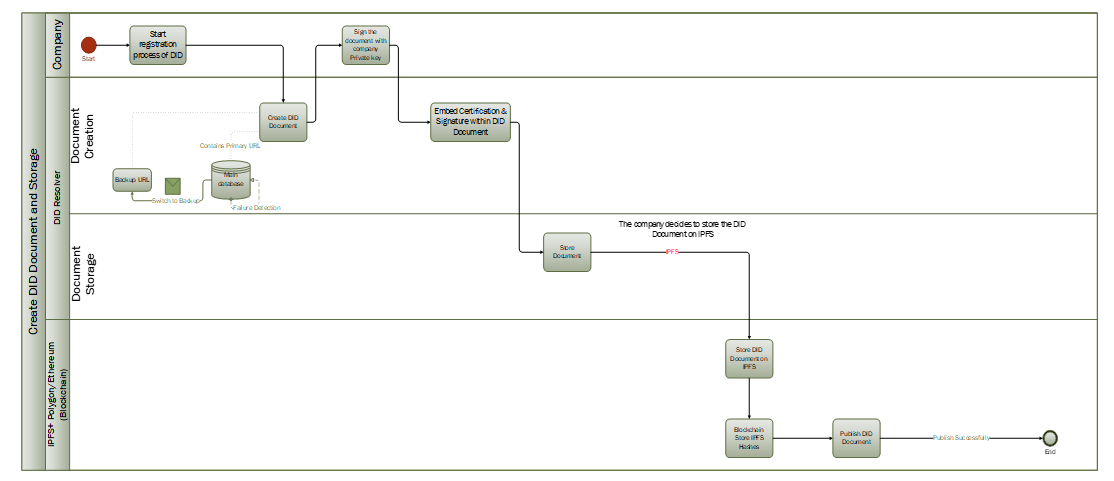
Table Of Content
DID Document Creation and Storage Through Blockchain
1.Start Event:
- The process begins when a company initiates the DID (Decentralized Identifier) registration.
2.DID Resolver Creates DID Document:
- The DID Resolver creates a DID Document, which includes two links pointing to the main and backup databases.
3.URL Monitoring:
- The resolver system monitors the availability of the main URL.
- If the main URL goes down, the monitoring system detects this and triggers a response.
- The resolver system then switches to the backup URL to ensure continuity.
4.Document Signing:
- The company signs the DID Document with a private key.
5.Embedding Certification and Signature:
- The DID Resolver embeds certification and the signature into the DID Document.
6.Storing on Ethereum/Polygon:
- Deploy Smart Contract: A smart contract is deployed on Ethereum or Polygon.
- Publish DID Document: Using smart contracts, the DID Document is published directly on the blockchain to ensure that it is securely stored.
7.End Event:
- The process concludes with the DID Document stored and published on Ethereum or Polygon.
The above steps outline a secure and resilient method for creating, certifying, and storing DID documents directly on blockchain platforms like Ethereum and Polygon, with mechanisms for continuous access through URL monitoring and fallback options.
Explanation of DID Document Creation and Storage on IPFS
1.Start Event:
- The company initiates the DID registration process.
2.DID Resolver Creates DID Document:
- The DID Resolver generates a DID Document, with links to both the main and backup databases.
3.URL Monitoring:
- The resolver system monitors the availability of the main URL.
- If the main URL is down, the monitoring system triggers a response.
4.Switch to Backup URL:
- The resolver system switches to the backup URL to maintain access.
5.Document Signing:
- The company signs the DID Document using a private key.
6.Embedding Certification and Signature:
- Certification and signature are embedded into the DID Document by the DID Resolver.
7.Storage on IPFS:
- Store on IPFS: The company decides to store the DID Document on IPFS (InterPlanetary File System).
- Publish IPFS Hash on Ethereum/Polygon: The IPFS hash, which references the stored document, is published on Ethereum or Polygon to secure the document’s integrity.
8.End Event:
- The process ends with the IPFS hash being securely stored and published on Ethereum or Polygon.
The IPFS-based approach offers decentralized storage for DID documents with blockchain-secured verification. This method ensures document availability via IPFS with blockchain linkage for integrity, combining the benefits of decentralized data storage and robust blockchain technology.
Our services
To understand how ComplyMarket can support you to build your Digital Product Passport, visit this Page or contact us directly.
Warning: ComplyMarket Solutions are patented and any use without written permission from ComplyMarket will lead to severe legal consequences.
written by : Alaa Rezk , Senior software developer
Share with your community
Comentarii
Lăsați un comentariu sau puneți o întrebare


